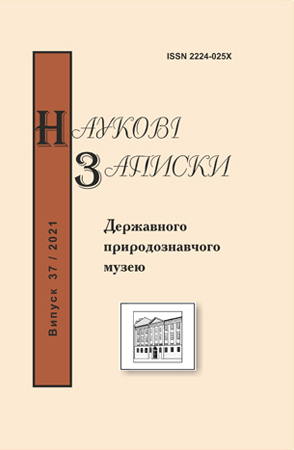Hoivanovych N., Bryndzia I.
Quality monitoring of well waters of Zhydachiv district of Lviv region // Proc. of the State Nat. Hist. Mus. - Lviv, 2021. - 37. - P. 105-114 DOI: https://doi.org/10.36885/nzdpm.2021.37.105-114 Key words: Drinking water, ecological condition, total microbial count, coli-index, nitrites, nitrates, ammonium ions, phosphates, chlorides, mineralization, biotesting The article presents the results of the study for well water quality in Zhydachiv district on the following indicators: total microbial count, coli index, content of nitrites, nitrates, ammonium ions, phosphates and chlorides, mineralization and pH. Exceedance of regulatory values for the content of nitrates, chlorides and ammonium ions was established. Studies of the total microbial count in drinking water have shown that the average annual values correspond to the norm only in some settlements in the winter, and in some cases exceed 2.2-9.8 times. The same tendency for changes is inherent for the coli-index in the studied water, where exceedances of 2.3-6.9 times were observed. Seasonal biotesting of well waters was carried out. It was found that most of the tested samples do not meet the standard for sanitary and hygienic indicators. The phytotoxicity index varies from low (Vilkhivtsi, Zhyrova) to high (Zhydachiv) pollution level. As a result of the study, it was found that the toxicity rates are lowest in the autumn-winter period, while they are the highest during spring-summer.
Quality monitoring of well waters of Zhydachiv district of Lviv region // Proc. of the State Nat. Hist. Mus. - Lviv, 2021. - 37. - P. 105-114 DOI: https://doi.org/10.36885/nzdpm.2021.37.105-114 Key words: Drinking water, ecological condition, total microbial count, coli-index, nitrites, nitrates, ammonium ions, phosphates, chlorides, mineralization, biotesting The article presents the results of the study for well water quality in Zhydachiv district on the following indicators: total microbial count, coli index, content of nitrites, nitrates, ammonium ions, phosphates and chlorides, mineralization and pH. Exceedance of regulatory values for the content of nitrates, chlorides and ammonium ions was established. Studies of the total microbial count in drinking water have shown that the average annual values correspond to the norm only in some settlements in the winter, and in some cases exceed 2.2-9.8 times. The same tendency for changes is inherent for the coli-index in the studied water, where exceedances of 2.3-6.9 times were observed. Seasonal biotesting of well waters was carried out. It was found that most of the tested samples do not meet the standard for sanitary and hygienic indicators. The phytotoxicity index varies from low (Vilkhivtsi, Zhyrova) to high (Zhydachiv) pollution level. As a result of the study, it was found that the toxicity rates are lowest in the autumn-winter period, while they are the highest during spring-summer.
References
- Berezhnov S.P. Pytna voda yak faktor natsionalnoi bezpeky / S.P. Berezhnov // SES profilaktychna medytsyna. 2006, №4. S. 8-13. [In Ukrainian]
- Bryndzia I.V., Tsaitler M.Y., Dosviadchynska M.R. Monitorynh dovkillia. Metodychni rekomendatsii do vykonannia laboratornykh robit. Drohobych: Reaktsiino-vydavnychyi viddil DDPU im. I. Franka, 2014. 148 s. [In Ukrainian]
- Bryndzia I.V. Otsinka yakosti poverkhnevykh vod Prykarpattia za yii fizyko-khimichnymy pokaznykamy / Iryna Bryndzia // Naukovi zapysky Ternopilskoho natsionalnoho pedahohichnoho un-t imeni V. Hnatiuka. Seriia Biolohiia, 2011. – №2 (47). – S. 7-11. [In Ukrainian]
- HOST 2874-82 “Voda pytevaia. Hyhyenycheskye trebovanyia y kontrol za kachestvom” // Kyiv, 2001. 59 s. [In Russian]
- Derzhavni sanitarni normy ta pravyla «Hihiienichni vymohy do vody pytnoi, pryznachenoi dlia spozhyvannia liudynoiu»: DSanPiN 2.2.4-400-10. Kyiv, 2010. 104 s. [In Ukrainian]
- Prokopov V.O., Kuzminets O.M., Sobol V.A. Stan detsentralizovanoho hospodarsko-pytnoho vodopostachannia Ukrainy // Hihiiena naselenykh mists. 2008, №51. S. 63–67. [In Ukrainian]
- Snizhko S.I. Otsinka ta prohnozuvannia yakosti pryrodnykh vod: Pidruchnyk. K.: Nika-tsentr, 2001. 264 s. [In Ukrainian]
- Gerba Charles. Drinking Water Treatment. Chapter 25. Environmental Microbiology (Second Edition). 2009, P.531-538. URL: https://www.cdc.gov/healthywater/drinking/public/water_treatment.html
- Hoivanovych N., Antonyak H., Kossak H., Krupinska E. Monitoring quality of well waters in Sambir region by physical and chemical indicators. Chapter 8. State of environment and human health / Ed. by A. Krynski, G. K. Tebug, S. Voloshanska. Czestochowa: Publishing House of Polonia University «Educator», 2019, P.91-100
- Hoivanovych N., Antonyak H., Pavlyshak Y., Bontey N. Quality analysis of water supply sources by hygienic indices using an example of the specialized regions in the Lviv region // Acta Carpathica 28. 2017. P. 55 – 61.
- Hoivanovych N., Halii S., Stelmakh V. Assessment of phyto- and cytotoxicity for well water of some settlements of Drohobych district // Conference proceedings SMART SOCIETY 2020 (student section). 2020. Series: SS-05/01. P. 5-11.
- Kropyvnytska L., Stadnichuk O., Martynyuk I. State of the decentralized water supply sources and ways of improving the properties of water. Human health : realities and prospects. Monographic series. V. 2. «Health and Environment». Drohobych : Posvit, 2017. R. 211–220.
- Kropyvnytska L., Stadnichuk O., Martynyuk I., Kucher L., Kucher M. Decentralized water supply and its impact on public health. Sustainable Development and Human Health. Edited by Andrzej Krynski, Georges Kamtoh Tebug, Svitlana Voloshanska. Czestochowa: Educator, 2020. P. 96–106.


